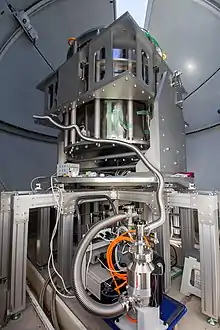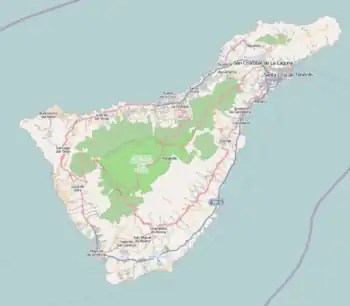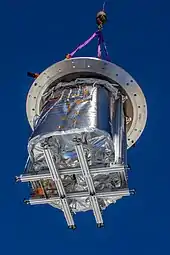 GroundBIRD in 2019 | |
| Part of | Teide Observatory |
|---|---|
| Location(s) | Tenerife, Atlantic Ocean, international waters |
| Coordinates | 28°18′02″N 16°30′37″W / 28.30042°N 16.51028°W |
| Altitude | 2,400 m (7,900 ft) |
| Wavelength | 145, 220 GHz (2.07, 1.36 mm) |
| Telescope style | cosmic microwave background experiment radio telescope |
| Diameter | 30 cm (1 ft 0 in) |
| Angular resolution | 0.5 degree, 0.3 degree |
 Location of GroundBIRD | |
| | |
GroundBIRD is an experiment to observe the cosmic microwave background at 145 and 220GHz. It aims to observe the B-mode polarisation signal from inflation in the early universe. It is located at Teide Observatory, on the island of Tenerife in the Canary Islands.
Scientific goals
The telescope was constructed to measure the B-mode signal in the polarisation of the Cosmic Microwave Background (CMB),[1] in order to look for evidence of cosmic inflation in the early universe. It aims to observe the reionization bump at and the recombination peak around .[2] The name 'GroundBIRD' indicates that the telescope is ground-based, while BIRD stands for B-mode Imaging Radiation Detector.[2] It is related to the future, similarly-named, LiteBIRD CMB satellite.
Telescope

The telescope consists of two mirrors in a Mizuguchi-Dragone configuration, with a diameter of 30 cm (12 in). The telescope is inside the cryostat, which is mounted on a rotation table, with a rotary joint that provides helium gas and electricity to the cryostat.[2][3] The mirrors are cooled to 4 K (−269.15 °C) using a Pulse tube refrigerator to reduce the thermal noise from the mirror surfaces.[2]
The experiment uses microwave kinetic inductance detectors (MKIDs),[4] which are cooled to 250mK by a sorption cooler within the cryostat, which uses helium-3, and was manufactured by Chase Research Cryogenics Ltd.[2] The signals from the detector are multiplexed, and around 100 detectors can be measured in both phase and amplitude with a single digital read-out system with a bandwidth of 200MHz, recording 1,000 samples per second. The digital system uses 12-bit ADCs and a Kintex-7 FPGA from Xilinx initially,[4] and now uses Kintex ultrascale FPGAs. Raspberry Pis are used to monitor and control the telescope.[5]
The cryostat rotates at 20 rpm (120° per second, 1 rotation every 3 seconds) to minimize 1/f noise.[2][6][7] It observes at zenith angles up to 20°, mapping around 40% of the sky. The field of view is 10°, with an angular resolution of 0.5° FWHM at 145GHz, and 0.3° at 220GHz.[2] It will measure the CMB at [6]
The telescope was constructed at KEK in Japan.[2] Test observations started in Japan in 2014. While it was originally intended that it would observe from the Atacama Desert in Chile,[6] an agreement to install it at Teide Observatory was reached in 2016,[8][1][9] at an altitude of 2,400 metres (7,900 ft).[2][10] It was shipped to Tenerife in January 2019.[7] In February 2020, the experiment was visited by Kenji Hiramatsu, the Japanese Ambassador to Spain.[11]
Collaboration

The collaboration includes scientists from:
- Delft University of Technology, Netherlands[2]
- The Graduate University for Advanced Studies, Japan[4]
- Korea Astronomy and Space Science Institute, Korea[2][12]
- Instituto de Astrofísica de Canarias, Canary Islands, Spain[2]
- KEK, Japan[2]
- Korea University, Korea[2]
- Kyoto University, Japan[2]
- National Astronomical Observatory of Japan, Japan[2]
- RIKEN, Japan[2]
- Saitama University, Japan[2]
- Tohoku University, Japan[2]
- University of Tokyo, Japan[2]
Funding

The project is funded by:
- Ministry of Education, Culture, Sports, Science and Technology, Japan[4][6]
- The Graduate University for Advanced Studies, Japan[6]
- National Astronomical Observatory of Japan, Japan[6]
- National Research Foundation of Korea, Korea[6]
with additional support from:
References
- 1 2 PROVINCIA, LA (16 December 2016). "Tenerife suma un telescopio para buscar la huella del 'Big Bang' en el Universo". La Provincia - Diario de Las Palmas (in Spanish). Retrieved 16 November 2020.
- 1 2 3 4 5 6 7 8 9 10 11 12 13 14 15 16 17 18 19 20 Choi, J.; Génova-Santos, R.; Hattori, M.; Hazumi, M.; Ishitsuka, H.; Kanno, F.; Karatsu, K.; Kiuchi, K.; Koyano, R.; Kutsuma, H.; Lee, K.; Mima, S.; Minowa, M.; Nagai, M.; Nagasaki, T.; Naruse, M.; Oguri, S.; Okada, T.; Otani, C.; Rebolo, R.; Rubiño-Martín, J.; Sekimoto, Y.; Suzuki, J.; Taino, T.; Tajima, O.; Tomita, N.; Uchida, T.; Won, E.; Yoshida, M. (2018). "Status of the GroundBIRD Telescope". EPJ Web of Conferences. 168: 01014. Bibcode:2018EPJWC.16801014C. doi:10.1051/epjconf/201816801014. ISSN 2100-014X.
- ↑ "ロータリージョイント | TKD(株)武田エンジニアリング". www.takeda-eng.jp.
- 1 2 3 4 5 Ishitsuka, H.; Ikeno, M.; Oguri, S.; Tajima, O.; Tomita, N.; Uchida, T. (13 January 2016). "Front–End Electronics for the Array Readout of a Microwave Kinetic Inductance Detector Towards Observation of Cosmic Microwave Background Polarization". Journal of Low Temperature Physics. 184 (1–2): 424–430. Bibcode:2016JLTP..184..424I. doi:10.1007/s10909-015-1467-7. S2CID 111807277.
- ↑ "GroundBIRD telescope". The MagPi magazine. Retrieved 9 August 2022.
- 1 2 3 4 5 6 7 Oguri, S.; Choi, J.; Hazumi, M.; Kawai, M.; Tajima, O.; Won, E.; Yoshida, M. (28 February 2014). "GroundBIRD Experiment: Detecting CMB Polarization Power in a Large Angular Scale from the Ground". Journal of Low Temperature Physics. 176 (5–6): 691–697. Bibcode:2014JLTP..176..691O. doi:10.1007/s10909-014-1138-0. S2CID 121462368.
- 1 2 "茨城)宇宙の膨張、証拠を探せ 原子重力波観測に新装置:朝日新聞デジタル". 朝日新聞デジタル (in Japanese). Retrieved 16 November 2020.
- ↑ "Japón buscará evidencias del Big Bang desde el Observatorio del Teide". The Diplomat in Spain. 9 January 2017. Retrieved 16 November 2020.
- ↑ S.L, Titania Cía Editorial. "Experimento japonés se suma en Canarias a buscar primeros pasos del Universo - Miércoles, 14 Diciembre 2016 20:16". El Confidencial (in Spanish). Retrieved 16 November 2020.
- ↑ INC, SANKEI DIGITAL (27 January 2019). "【クローズアップ科学】原始重力波の証拠を探せ 宇宙誕生の謎、日本も本格観測". 産経ニュース (in Japanese). Retrieved 16 November 2020.
- ↑ Time, El. "El embajador de Japón en España visita el Roque de Los Muchachos". El Time (in European Spanish). Retrieved 16 November 2020.
- ↑ "Department Information | KASI". www.kasi.re.kr. Retrieved 26 August 2020.
- ↑ "About OpenIt — Open-It". openit.kek.jp. Retrieved 20 December 2019.